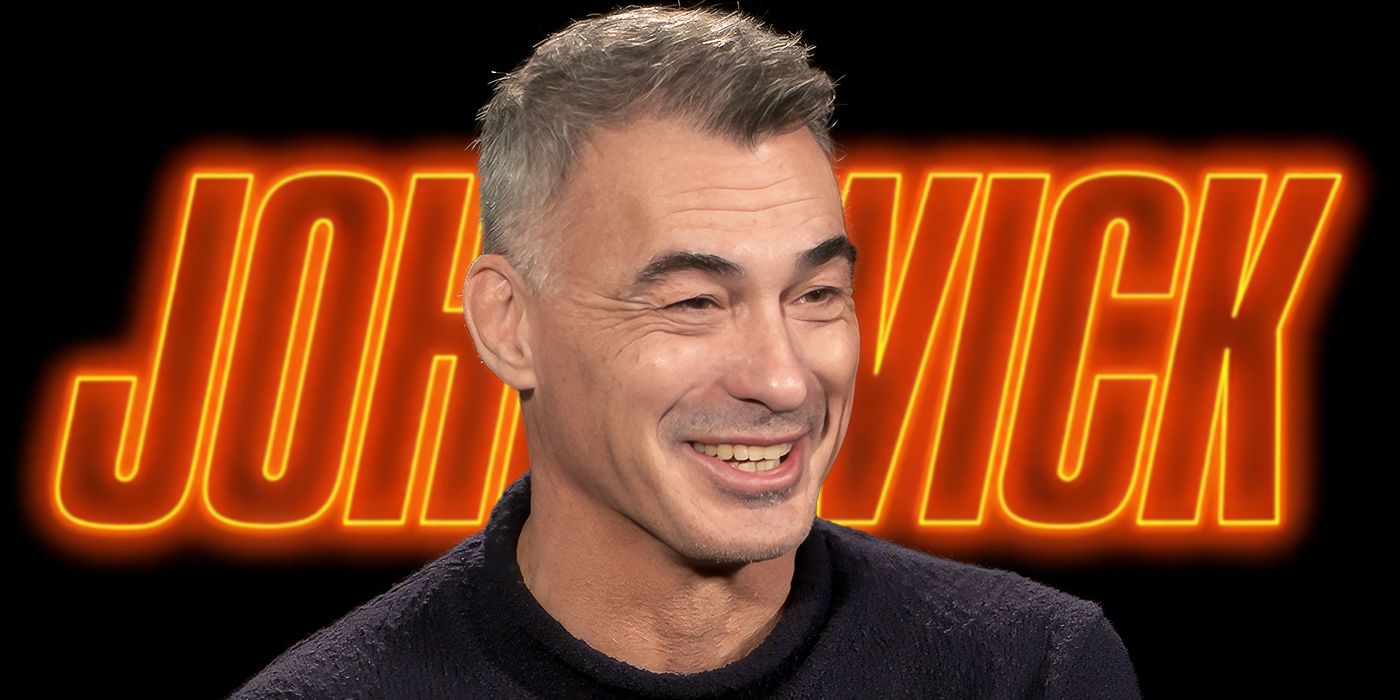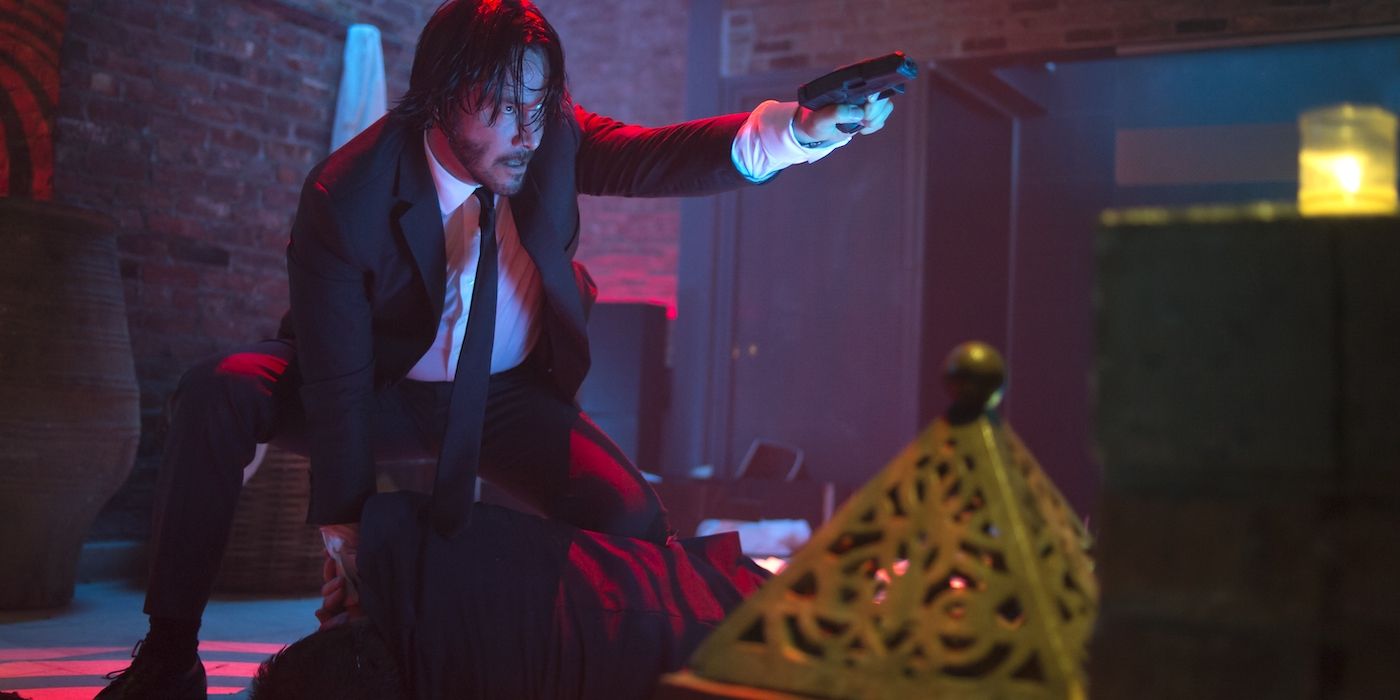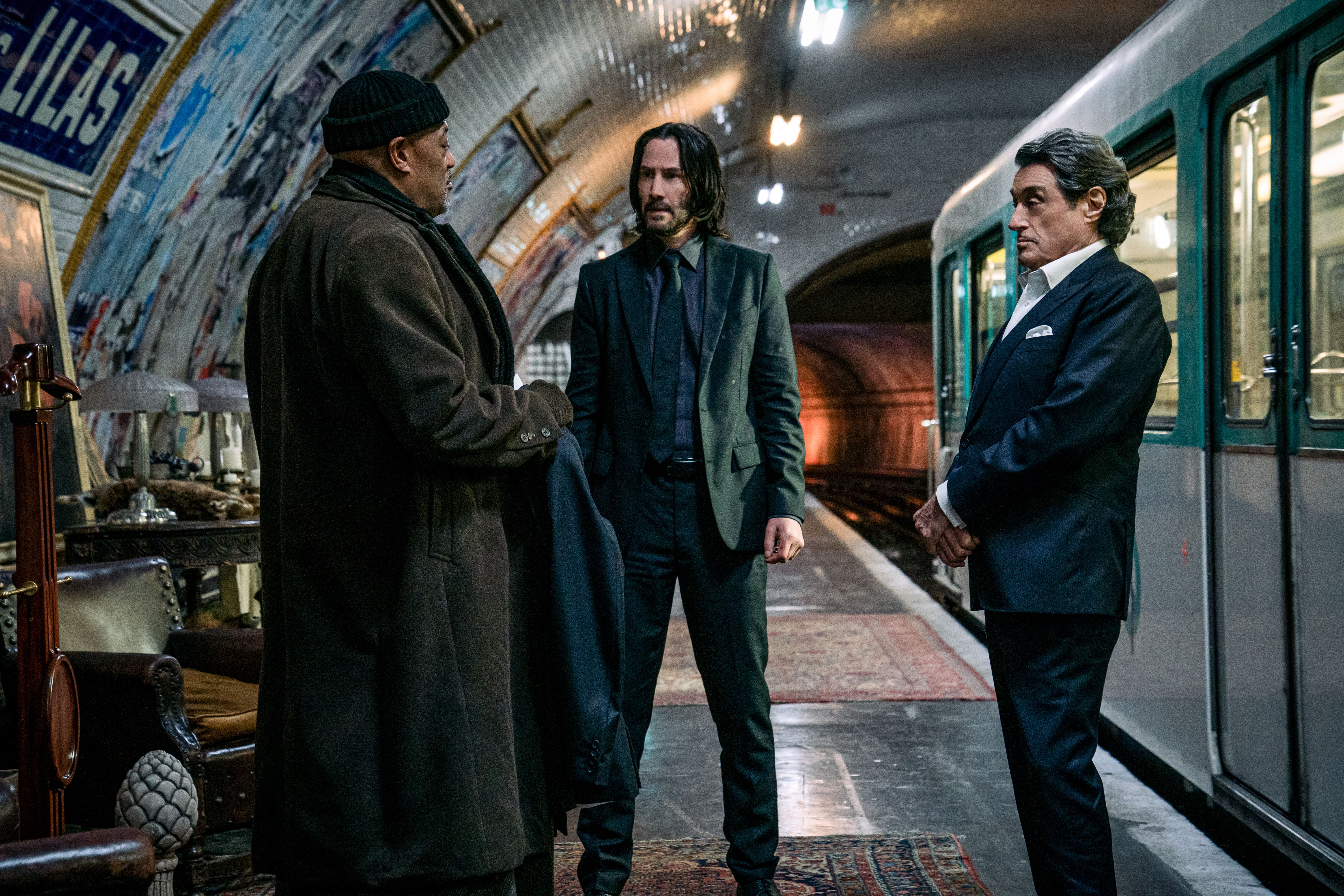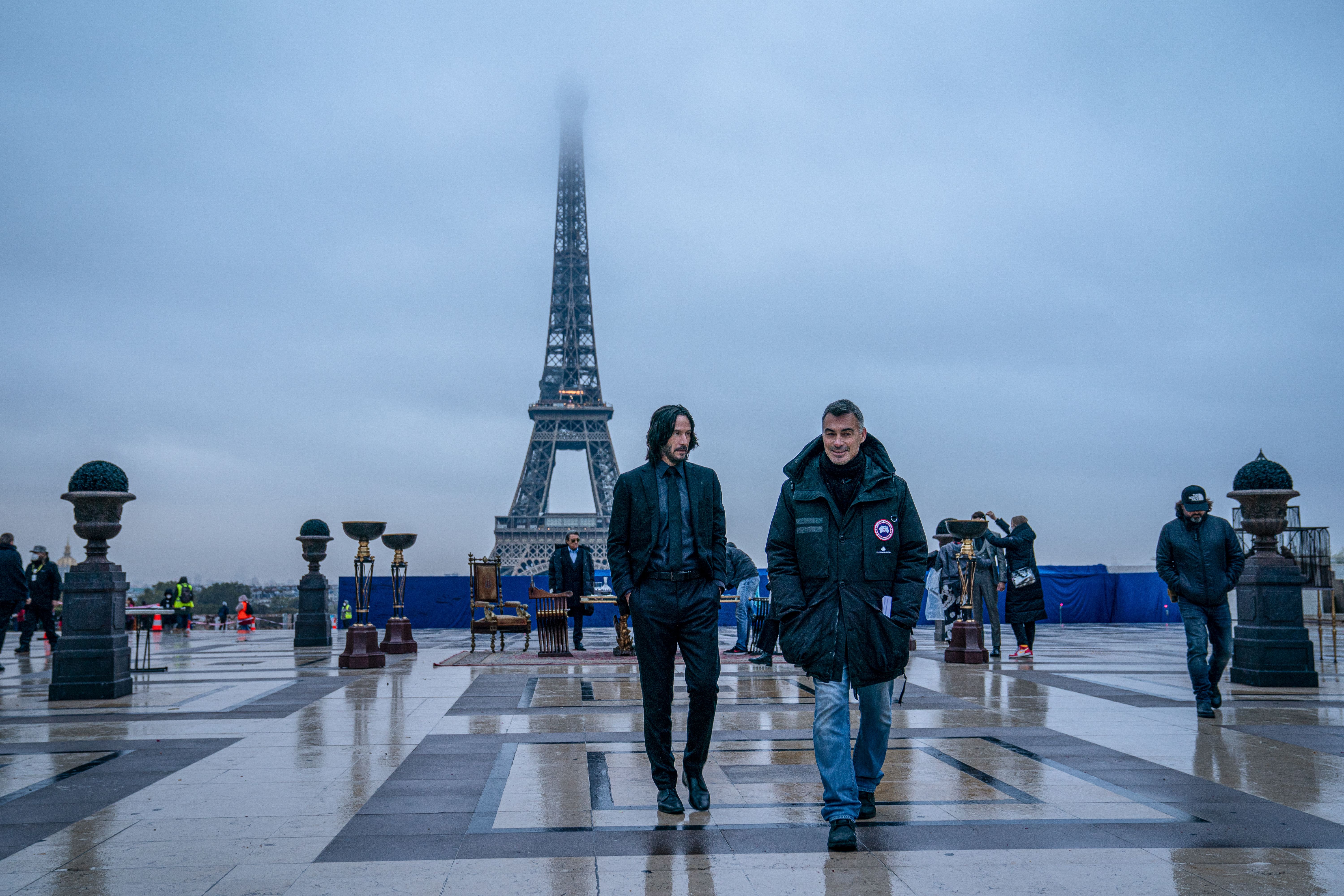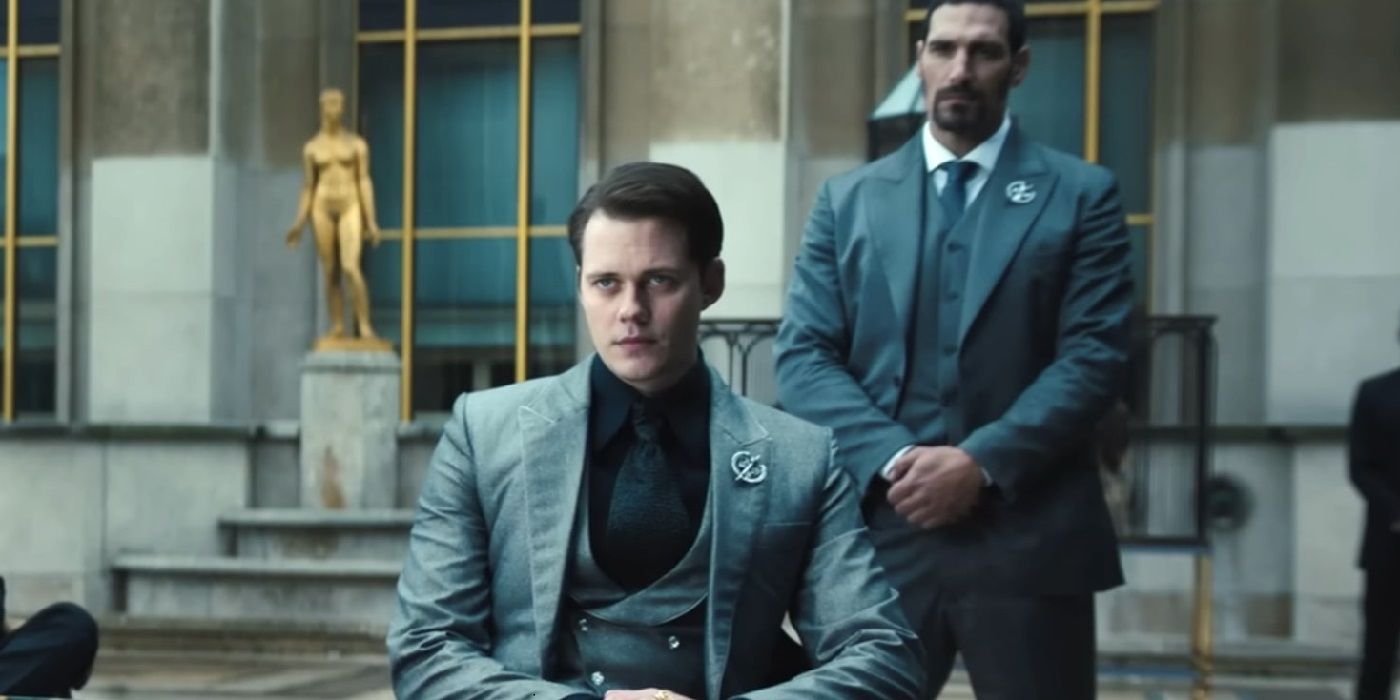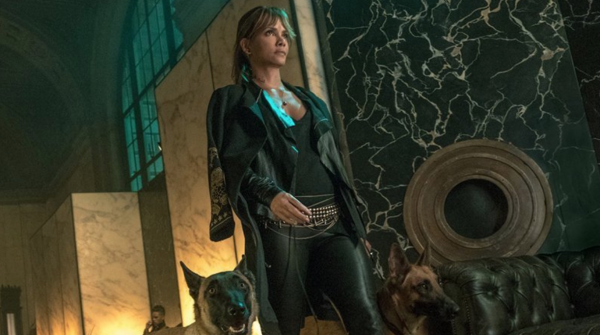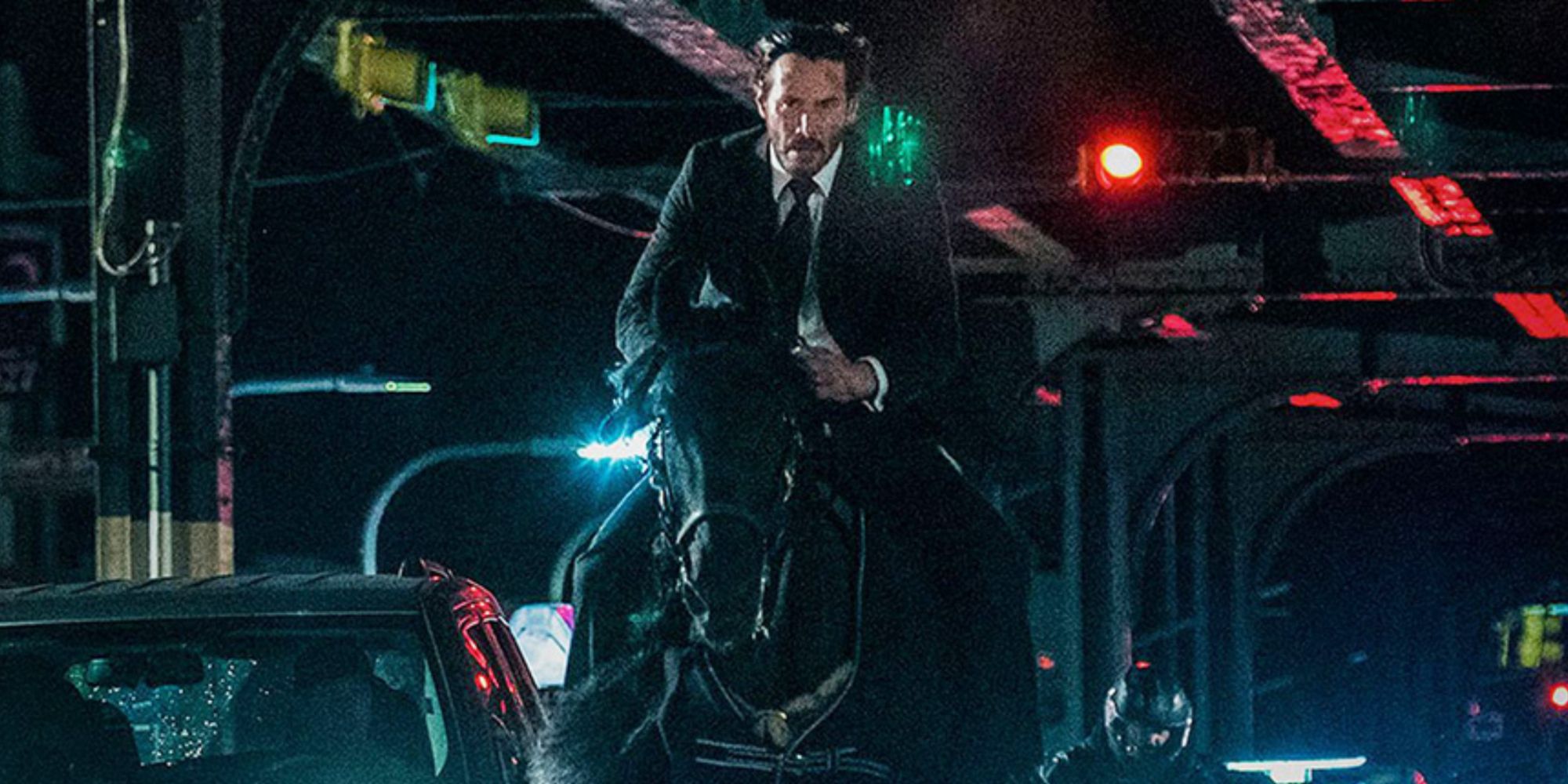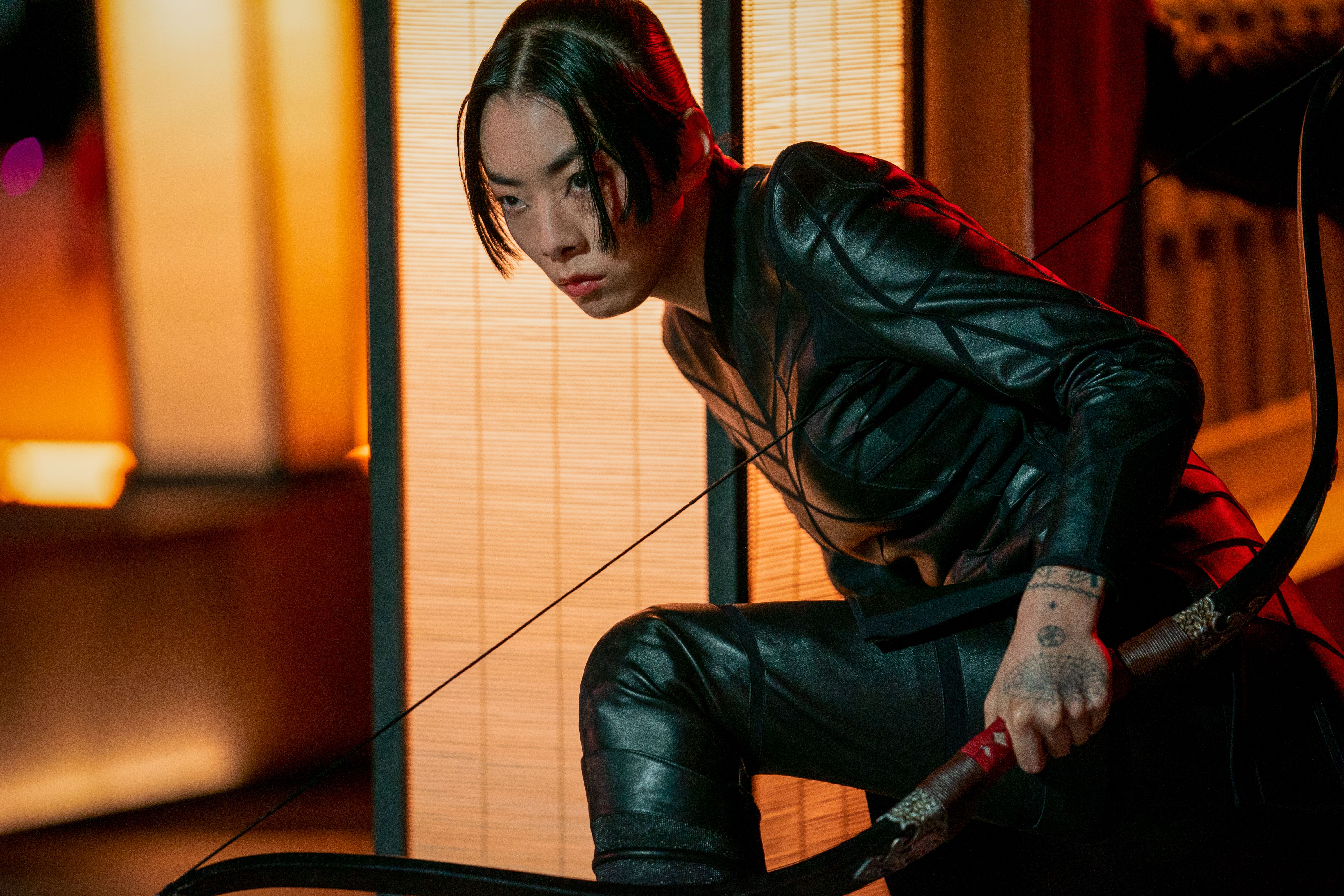[Editor's Note: The following contains spoilers for John Wick: Chapter 4]
Stuntman-turned-director, Chad Stahelski, was always the right person to partner with Keanu Reeves on a larger-than-life franchise like John Wick. Between his time spent understanding the mechanics and limits a human body can be put through, and his passion for all things martial arts and cinema, it’s no wonder John Wick: Chapter 4 was a mash-up of everything that makes action films so epic. For nearly a decade, Reeves’ has played the titular assassin with a chip on his shoulder, a debt needing to be collected, and in this fourth and possibly-final entry, everything comes to a satisfying conclusion. In what Stahelski calls a “Greek myth”-type tale in his interview with Collider’s Steve Weintraub, the mythos of Wick finds its poetic culmination.
During their discussion, which you can watch in the video above or read below, Stahelski tells all. He breaks down how he and Reeves brainstormed each installment over whiskey, how the two of them schemed up the unbelievable stunts that somehow always top the movie before. It’s clear the way that Stahelski effortlessly rattles off a number of influences that his passion for cinema goes beyond trying to top his own limit-pushing stunts, and he shares with us why Wick went on an odyssey in Chapter 4. The director reveals where Bill Skarsgård’s The Marquis originated, and whose idea it was to have John Wick take the bullet, as well as why it needed to happen.
If, like us, you always need more after that end-credit scene, Stahelski breaks that down, as well, with the concept behind every detail. In a stream of consciousness, he takes us through the most difficult stunts throughout the entirety of the franchise, from the Arc de Triomphe to Halle Berry’s dogs in John Wick: Chapter 3 – Parabellum, how his excellent stunt team pulls off falling down the steps of the Sacré Coeur, with no CGI, and what could be next in the Wickiverse, as well as for him as a director. And if you’re still stuck on that ending, asking yourself, is John Wick actually dead? He answers that, too.
COLLIDER: I am very curious how a John Wick movie is actually made. So, I want to go back in time, John Wick 3 comes out, big hit, Lionsgate calls you, there's a meeting and they say, “We want to do a fourth.” What exactly happens there to get to the screen in terms of, how are you crafting your action set pieces? Where are you thinking about, like locations? Can you sort of take me through how this all got figured out?
CHAD STAHELSKI: Yeah, I wish it was a little bit more systematic, but it does happen like that. You know, the movie comes out, it does a certain degree of success. You get the call, you have the congratulatory Zoom call, “Yeah, good job! We're awesome. It's great. Whoohoo!” Then you get the, “Well, what do you say?” And it's kind of a joke, “What do you say? Let’s just jump right back in,” and you get the next one, and you're just like, “Ehhh…” Because you feel all this weight and pressure on you.
It's not that you don't want to. It's just like, “OK… what do we do?” And everyone starts trying to plan, and it's hard to plan an idea. It's like, you can't just go, “Tuesday, 5:00, we're gonna come up with good ideas.” Like, it doesn't happen that way. So, I get kind of resistant. I'm like, “Yeah, I'm not ready to talk about that yet.” And they just kind of go like, “Well, well…” It's like, “No, you're not hearing me. I'm not ready to talk about that yet,” and you need to hang up.
Then, it was probably four-and-a-half, 5 months later in Japan, they release a little bit later. We've always had a delayed release there. So Keanu and I, we haven't seen each other in a couple of months, and everyone's done other projects or something like that. We'll get on the plane, we'll head over to Japan like we're going to do on this one, and then – I think it's twice now – but on John Wick 3, we're in the Imperial Hotel in Tokyo, they have a brilliant Scotch bar there and Keanu and I were like, “Yeah, fuck, that was a rough one. Let's, let's not do that again. Yeah, let's not do that again. That was good while it lasted. Good while it was good. Yeah, it was good, good experience, great experience. It was great, great, great, great. Yeah. No, no, it's good it's done. We can rest now. It's great. I don't know if we can do that. We're getting older. Yeah, I know. It's great. One more drink? Yeah… I got an idea.”
And that's how it always starts. And we love Japan, we're like, “Wouldn't it be cool if we did an Osaka Continental?” Like, “Yeah, it would have been cool. But that's done.” And at the time, I literally think I'd watched The Good, the Bad, and the Ugly on the way over, and I was like, “I got an idea. Let's have three. We did the John Wick story. Let's see the world from different perspectives. Let's see it from the High Table side, but we'll do a new sheriff in town, we'll do a Western!” And at the time I was also super into Zatoichi, I watched like 10 in a row, right? I was like, “Yeah, we gotta have a blind swordsman.” He's like, “Blind swordsman?” I'm like, “Yeah, a blind swordsman.”
I had also just watched David Lean's, you know, Lawrence of Arabia. I'm like, “We gotta go back to the desert. We love Morocco. We gotta go to Aqaba, Aqaba by land.” We just started drinking and laughing like, “Aqaba by land! No, blind swordsman. No, fuck you, we’re gonna do it in Osaka. A samurai! Yeah, that'd be great. Have you ever shot a bow and arrow? Let's do bows and arrows.” And then we were like, “John Wick with nunchucks.”
And you start riffing these ridiculous ideas and they all go into this little notebook that I carry around. Cut to [when] we get back to L.A., and I'm like, “Maybe those were good,” and you go to the whiteboard and you start going “Nunchucks…” and that's all you have. And you write Lawrence of Arabia, Aqaba, and you circle it, and then you go, “Oh, trilogy character. The Good, the Bad, and the Ugly. You know, we'll have a blind swordsman meets a guy that's a tracker. We’ve got to have a dog.” And you start drawing these circles, and that's kind of how it started.
Then, we didn't have an overall plan, overall plot, overall story. We just knew John Wick has to realize what he's done. We keep talking about consequences, we’ve got to see real consequences, and John Wick has to learn, but he can't just say, “I've learned it and I want redemption.” You gotta see the pain on his face because we're a show-don’t-tell kind of movie. So we wrote the scene, and ended up being the Hiroyuki scene on the roof where there's that one great line, one of my favorite lines of movie, like, “Friendship means little when it's convenient,” and that's when it hits John, like, whoa, he's actually burdened somebody, like somebody's going to pay the cost of it until Rina tells him, “You don't understand what you've done. Because of your shit, my dad's gonna pay, an innocent in this,” and we just want to keep hitting Keanu's character with that.
So we knew that theme was there. Like, how does everybody John bumps into– He kind of screws up a little bit because he keeps putting this burden on him. John shows up at your door, John doesn't think of the burden he's putting on you. And then halfway through the movie, we wanted John to realize like, “Oh fuck, yeah, this is a bad thing. I gotta do something good.” And we had to make him earn that by actually, you know, letting him take the bullet at the end for Donnie, that kind of thing.
So, we knew we wanted that theme and we knew we wanted nunchucks and dogs and cars. And it's funny, I've always been a fan of some of Joe Rogan's podcasts, but I ended up bumping into him at the gun range once, and I was like, “Hey, how are you doing? I'm the guy that does John Wick.” He's like, “I'm Joe Rogan,” and, you know, he didn't even miss a beat. He's like, “What happened to the muscle cars? Where are the muscle cars? I'm at Taran Butler's gun range and we're just shooting, and he keeps going like, “I love muscle cars, man. Great movie, but where are the cars?” So I wrote in the notebook, “Put muscle car back in. Joe Rogan hates me.” I’m like, “Okay, Joe. What car would you put in?” “‘71 Barracuda.” Didn't miss a beat, “‘71 Barracuda.” I'm like, “Alright, ‘71 Barracuda is going in the movie.” And then you figure ways to put that in. I think that's a lot of how we do it on John Wick, the overall creative process starts with this giant whiteboard, like I've told you before, we put down all these ideas. “Good, the Bad, the Ugly, Zatouichi…” You know, “One car, why? Use reds more.” They just came up. “In the Mood for Love uses reds well, make sorrow, put red more,” and it starts like that.
My dad's a plumber, or was a plumber, and that was his business. And I remember when I was very young, I saw one of these water curtain things happen, like it came on and off, and that was the coolest thing I've ever seen. Use that. So you do a little research. 40 years later, I'm putting water curtains in, 44 waterfalls in a dance club to techno music. And I just thought, “That's how it starts, with all these ideas.” Then you go to Keanu, “What do you love?” “I want to be back on the horse. I think John Wick needs to tie together like this. I think we need to include all three films and wrap them up,” and he looks right at me and doesn't miss a beat and he goes, “John Wick's gonna die.” Like, “John Wick has to die.” I was like, “Whoa, you want to kill the character?” He said, “John Wick has to die.” That was our whole– we gotta hang our hat on that, like, just fuck it. Don't care who's upset by it. We're gonna do it.
We were like, “Okay, well, that's how we'll start writing the story,” and we roll backwards from that point on to get there like, “What's a deserved death? What makes him think he's gonna take that bullet?” And that's how we went back every step of the way to design the scenes. And it kind of just stated like that.
As far as action goes, there were a couple of scenes that we had written that we cut out, like I'd love to do an underwater sequence, or like a Thunderball. I wrote down, like one of the earliest, “Beat Thunderball, do underwater spirit gun sequence with John Wick style.” Like, OK, how's that gonna work? So I went, actually, to Lanai, and I went to this famous dive spot in Hawaii and it went underneath to Cathedrals, they call it, and you know, you sit underwater, you wait for the light to hit at 60 feet… So I go, “Okay, I'm gonna shoot at Cathedrals, and we're shooting in Hawaii, we're gonna get 60 stunt guys and we’ll all do Thunderball.” So that went in the script.
It was supposed to be off Maltos Coast and stuff because we had this nice Templar idea, and then we're like, “Snowmobiles in the city, snow, blood looks cool in snow. So do a lot of snowmobile stuff.” And we're like, “We’ll have a snowmobile chase in it.” Then you're like, “Arc de Triomphe, a gunfight in traffic. Boom.” And we started reverse-engineering that out. And everything I'm talking about, it seems like it comes up, but that right there is about six months of just screwing around with scenes and story, no script, just– we'll write a scene, like we wrote the Louvre scene very early on. We just loved the idea of being in front of the Wrath of Medusa and, you know, have this French scene.
We knew we wanted to call the guy The Marquis. He was the new sheriff in town. You know, like, High Noon. We wanted not a High Table member, but we wanted– you know, who's the sheriff? Who's gonna clean up this mess? Who's gonna come down and lay down the law? And we're like, we're gonna call that guy The Marquis, and he's gonna have this little sheriff's badge, and that's why you see the pin in the movie the whole time. Like, you know, “You're the new sheriff, here's the thing.”
And, you know, we kind of took a lot of the John Ford, Leonie western vibe, and mixed it together with Asian cinema, and that's how we kind of got the vibe, which is really like the first half of the movie.
So I'm curious, what is it like to go into the studio and say to them, “So Wick, we're gonna kill him off in this movie.”?
STAHELSKI: Got a lot of faces. I mean, I have a very good relationship with Lionsgate. They're great, they've been very supportive, but I don't think any exec or any producer in the world would smile when you say you're gonna kill off their successful franchise character.
But, you want to have that confrontation, like, “Look, this is what's right,” but you’ve got to see it from their side, too. I'm the guy that pitched, you know, nine years ago, “Hey, I'm gonna do an action movie, I want to start by killing a puppy, and I’m gonna shoot 80 people in the face over a puppy, and I’m gonna kill Alfie Allen, and then that's it.” “Oh, but the bad guys killed his wife?” “No, she died of a disease.” That's a hard pitch. John Wick never pitches well on paper, you know? Like, I'm gonna do ninjas on motorcycles… it doesn't read well.
So when you read, “And then John Wick dies and gives his life for the…” you're like, “What? Wait, wait back up. What?” So you try to understand their perspective on it, and you're like, “Look, I get it. It's in the execution, it's gonna be a longer movie.” It was 135-page script. We knew we were gonna be in the two-and-a-half hour mark at least. We're like, “Look, let me give it a go, and I want to do you a solid, like, we have this duality thing going on, John and John Wick. Whether you look at it or not as John Wick’s dead, or John and John Wick are dead, or it's a split and maybe one's off somewhere on a desert island, whatever, however you want to interpret that… But you know, let me try to execute it the way we are. Let me build the story around it and I'll do you a solid. I'll tell you what, I'll shoot the ending two ways, you know, with one extra little thing, two extra little shots. I'll let you know he's alive, and I'm gonna leave it up to the audience to decide, and we're gonna test both.”
And they were super cool. They let me go through the whole movie. They let me and Keanu devise a whole strip based on this ending of the character kind of thing, his demise, his death, and why he dies, and that's really what the movie is about. And I'll do it two different ways, and we tested it, and we all looked at it, and you know, the test audience has definitely had a favorite of that, which is the ending that you guys saw, and it was nice to show and get actual feedback about like, “You're right, this is really strange,” but it misses the punch, it misses the ending and it makes the whole movie worth it in a cathartic kind of way to end like we did.
And everyone was very understanding of that, and it was good to come to that conclusion together without having to fight it or force it. And, as you can see, obviously, they're supportive of the ending that, but it wasn't an easy sell. It had to be proved, and even, like, we felt it was the right direction to go, but you don't know until you sit in that room with 3, 400 people and you really feel it.
Do you think that everyone was in a good mood though because John saved another dog? Do you think that also helped elevate the score here?
STAHELSKI: I'll take whatever I can get. If that was a little bit of an emotional manipulation that could have been in there, I'm not gonna say… yeah, I'll take what I can get on that one.
I'm sure there are going to be people that ask, is John Wick officially, in your perspective, is he dead?
STAHELSKI: Again, not to be evasive, this has always been a campfire tale, right? It's meant to be a myth. It's not meant to be a movie. It's not meant to be a plot. It's meant to be a little bit of tale, a fable, right? And fables are always unsure because the ending is always like, “What are you getting out of it? What's the moral of the story?” So we're going to treat this like, “What's the moral of the story with John Wick? Is John really dead?” Well, John Wick is. I mean, that's his redemptive story.
Now, is the myth of John, the character of John in his little world– did he find a cool way to end that chapter so he could start anew somewhere else in a different life? I don't know, that's an interesting concept. I'm gonna leave you with that one.
You know, my personal opinion is probably a little bit darker than that, but I think that's a very open-to-interpretation kind of thing, and we kind of wanted it that way. So if this was a Greek myth, you'd kind of get like, “OK, it doesn't really matter which side of it died, or if he died as a human being. It matters that the John Wick persona died.
There is an after-credit scene. How did you decide on that scene?
STAHELSKI: It's funny, we shot that, there's a real scene that goes along, like Donnie coming up, you think he's got it, and then Rina goes and gets him, and then there's this whole death scene with Donnie Yen dying. We had a whole thing where you actually see the demise, but it was kind of a bummer. Not that we’re like, “John Wick, we’re hardcore, kill them all,” you know? That kind of thing. But we watched it and I kind of felt like, “Well, that's not as cool as not knowing.” Like, does Rina go down that road? You know, we have John Wick and his demise, and we’re like, “Well, let's open the door to the new John,” like, “Who's the new…” And we're like, “Akira.”
She's got the motivation she gave John the ultimatum. John chose not to honor that, but he chose to honor something much bigger. So, we had this whole scene and we're like, “Well, that doesn't really say what we want.” It was a little too much, and we didn't think it was really nailing it. So, my editor Nathan Orloff had a nice idea and was like, “What if we don't see it? What if you leave the audience to that? What's the choice?” Rina has a choice, she opens the knife, but does she actually, you know, hit Caine with it? And we're like, “That's awesome. Let's just try it.”
So we put it at the end and it's like, “OK, we want to be a little, you know, hard-boiled in our filmmaking with John Wick, but at the same time, I don't know, let's leave it open.” And it had that little bit of, “Alright. That was cool.” And it had that little punch to it, like, not too much, not too little, and you still don't know: So did she go down that dark road, or did she go, “not my battle”?
With this being the last chapter, have you had conversations with the studio about doing a special John Wick box set, of finding extras you have on the cutting room floor, all that stuff?
STAHELSKI: There's been a little talk about it with marketing and stuff. I think their main focus is trying to get the movie out there and do their thing, but Josh Oreck’s company, Narrator, has done a great job. I mean, they have hundreds of hours of behind-the-scenes footage and training from all the movies from very, very early on.
I think there's talk of doing a little bit of a special, like an hour special, or featurette, which is literally all four movies, you know, from the beginning, kind of tracking from my younger days to what I look like now, and to Keanu, and how we all limp now and all that. So, I think it's a very interesting– they showed me some of it, and it's very, very cool. Hopefully, they'll tie that in with the whole marketing scheme, but I would love to see it just for my own interest. I know there's a lot of talk about the video game world, the anime world, and, you know, hopefully, the TV world.
Yeah, I really am wondering why there hasn't been an amazing John Wick open-world kind of game.
STAHELSKI: I think they were just waiting for the right opportunity. And again, I think people are always trying to play– you don't know if you've got something you want to invest in until it does well. By the time it does well, now you're, you know, a three-year leeway to get to the game to go. So, I think Lionsgate in general kind of knew they wanted to go down that road. So I think for the last couple of years they have been working very intently on it and I think they're moving forward with something right now.
I need that. Just throwing that out there. The four John Wick movies have spectacular action, and each movie has a set piece that looks impossible to pull off. I'm just curious, how would you rank, in the four movies, what do you consider the five hardest sequences that you had to pull off?
STAHELSKI: Wow. Good question. Good question. Little trick for all the choreographers out there, it's very easy to come up with easy ideas. Does that make sense? Open space, there's nothing in your way. So you think you can do anything. You know, we'll clear out the room. “I don't want that table there because then I can't do my spin hook kick in…”
The opposite is actually true. The more obstacles you put in the way, the more interesting the choreography is. Think of Jackie Chan, you and I can do a decent fight scene, but if I handcuff us together, yes, it makes everything harder for both of us, it makes hard to shoot, but if you nail it, it's 10 times more interesting. If you want something more interesting, be subversive, show it in a different way. That's why we do the different lighting, the different things. Like Marcus Aurelius, right? Stoicism, the obstacle is the way.
I learned that from Jackie Chan very early on. He's like, “Make it hard. If it's easy choreography, don't do it.” And I go, “OK.” But, he always wrote up, “make it as difficult as you can.” But then you're like, “Well, how do I—?” You're not supposed to know because you haven't done it yet? So make it as hard as you can, and the interesting part is how you solve it. It's not the problem, it's the solution, and the true judge of character is how you solve it.
So, choreography should always be this inclusion of obstacle, or hardship, and how you solve it. That's what makes it memorable, right? It's always like that. So you take that with the scenes, and it's not hard to put car stunts and fights together, but it is hard to execute. There's a reason people haven't done that before because it's hard. So we're like, all right, well, if that's our model, let's see how bad we can screw ourselves. Let's say, “Dogs, cars, people,” and like, let's just try to run anybody over, or kill anybody, and let's put it all together, or like, let's try to do an entire 100-move sequence from the top, and move a camera in a tiny little space over and through walls, and let's… but wait a minute, that'll take thinking, you know. Well, ok, let's think. And I think that's a challenge. It’s funny, the smart creative people, the more challenge you give them, the more they get inspired, the more they want to work hard at it.
So if you had to have me rank all that, every sequence we do has some little hint like that. Some, we can afford bigger stuff, some we can't. I think out of the four, the most logistical where I was like, “Ok, please don't mess this up,” would definitely be the Arc de Triomphe sequence just because I have my lead cast member, as good as he is in a car, he's driving against five lanes of traffic. If any one person messes up at 35 mph, that's never a good thing. Like movie, nonmovie, we've made it as safe as we feel good, Keanu’s spent a lot of time driving, we have the best stunt drivers, we've coned off, we've come up with all these safety factors, but things can – obviously it's moving vehicles – things go wrong.
And then you have your lead actor with, with Makco our other lead, you know, running through five lanes of traffic, and those are real buses, those are real cars, like, you do not want to hit your lead cast with a tour bus. Always goes in [the] Bad column for directing. Don't run over a lead actor.
In stunts, you never want to get relaxed even though you got the best and you've done it, it's your fiftieth day of shooting and everything's gone off without a hitch. You never want to just get complacent and go, “Oh, you know, we've been doing…” If I'm not stressed out over a scene– because I get nervous, because that's when you get lazy, and when you get lazy, that's when you make mistakes. So you got to be switched on, and after two weeks of being switched on, it's a little exhausting, and I guess it's nice to see that it all comes together, but you don't know that until the end. So you're like, “Did I just risk all those people? Did I just do all this work not to get a good sequence?” But you don't know until the VFX are in, until the cars are in, until you edit, until the music’s in, and you’re like, “OKay, it was worth it.”
So that one was definitely in the top five, for sure. I would put the top shot in there just logistically trying to figure out, “OK, how are we gonna do this?” There's so much math going into where you have to put the camera, the camera to subject, how to get one lens to do it all without cutting, and all that stuff.
Mirror room in number two, very difficult. We had to put each of those mirrors on a 10-degree tilt swivel so we could always hide camera because we couldn't afford visual effects at the time. There's like two or three video effects wipeouts, but most of it is we had to hide camera people and crew with little angles, and, like, math is not my strongest subject, and you're going to figure that out.
Another top five would be Halle Berry in number three with the dogs. Dogs, I mean, as well trained as they are, it's dogs, and the dogs don't know it's a movie. So they're biting crotches, they're going for the target, and you just hope that they bite the target and not the person holding the target. That gets a little stressful. You know, you’ve got Halle, and there's so much going on. No one's ever done that with dogs before. No one's had 50 stunt guys and your lead, Halle Berry, shooting guns and all this stuff, and the dogs jumping over people, and literally biting and taking down stuntmen. Like, that's a real animal going at its fastest speed, being its most ferocious, taking guys down. Like, that's not a stunt, that's a real event. That's not fake. Those dog hits are real.
You know, obviously when you're hitting guys with cars, that's– gravity works, that's a thing. Physics are real, you know, that's not fake. Our best guys get hit by our best stunt drivers with, you know, 2000 pounds of metal. That always makes you go, “Okay…” So those car hits in the Arc de Triomphe are real. Those dog hits are real.
So what do we got? Arc de Triomphe, top shot, the Halle Berry sequence with that, and what's the other one? Oh, our mirror room was pretty tricky. So, fifth, what would that be?
Well, I mean, the waterfalls are always tricky with the club. We've talked about that. That's always a logistical nightmare when you deal with so many extras and stuff. But God, I think–
I like putting you on the spot like this.
STAHELSKI: Yeah, I know. It's good. It's good. It's making me think, you know? The horse chase in Brooklyn on number three was a little tricky because you don't know how that's gonna— is that gonna look really, really ridiculous, or is that gonna be cool? You know, fighting with the Sumo guy, fighting with the glass house.
So, I mean, they're all tricky but like, for myself, what I didn't know if it was gonna work, and which I think is the best fight for number three, which was a knife fight. And it sounds like, “Oh, that one didn't look that hard.” I think, conceptually, it made me nervous because in every movie you see a guy throw a knife in him and it sticks in, and it kills a guy right off the bat. And that whole purpose of that fight was to be completely subversive and go, “Yeah, knives don't always stick in.” And what does a snowball fight look like with knives? And I think, conceptually, we're like, “You're gonna think this is ridiculous. They’re gonna think he's terrible.” So I was a little stressed out about that one executing. It wasn't that bad, but conceptually, I was like, “I'm either gonna hit or miss with this one. It's either gonna be the coolest fight in the movie or it's gonna be the weirdest.” So, I'm kind of happy it turned out to be good.
I definitely want to talk about the Paris stairway sequence.
STAHELSKI: I put that one in the top six.
First of all, the sequence is crazy, but for people that maybe think that this is all CGI and stuff like that–
STAHELSKI: Oh, those are real stairs. That's actual Sacré Coeur.
Yeah, exactly. So my thing is, are these people that are going down the stairs all real guys, and how exactly are people getting up from that?
STAHELSKI: The stunt guys. My stunt team, we did a great job putting together a multinational stunt team on this great martial art stuntmen, great fight guys, and great physical gag guys, fall guys, basically. And you know, from the 80 7-11 team, to our Japanese team, to our Bulgarian team, just really great guys, and technology advanced so much. They use gel packs over hard elbow packs. We have this almost Kevlar-level padding body armor that we can put on the gel pack so the guys can withstand anything, but you still have to go down the stairs and get hit by the car, but it keeps the edges off a little bit. So it does help, but it is still going down 100 steps.
Like when you see that elongated stair fall that Vincent does, Keanu’s stunt double, he did that. In the first take, he didn't even make it down the first step, he got hung up on the railing, and the way he took off, you can see in the way he goes, he's like, “Here we go. No fear.” He had to do that twice, and on the second one, that take that you see in the movie, there's no stitching. It is 100% real. We cut when he stopped rolling. It is the second take, all in, no digital effects other than wiping out the camera that was tracking down, it was on a cable cam. So we actually brought the cable down and the guys on the control, trying to keep up with Vincent. So, you don't know because that's a hard one to rehearse. You just kind of go, “I think this is gonna work. 3, 2, 1, let's go.”
So what he did on that, that was literally human talent. Vincent put on very standard stunt gear and just had the heart of a lion, and just went, “OK, I'm going, and I'm gonna make it.” I wasn't, but some of the stunt team might have been betting on how many steps he would have made, and no one, no one, thought he was gonna make it down past halfway, and he went just past halfway and went about 65% of the way down the stairs, to 220 steps. And he did it all on the second take. Pretty impressive.
That's the thing about the John Wick movies is that every one of these, I'm always like, you know, the jaw goes down, but I think that's one of the reasons why the world loves these movies is because you guys are constantly doing stuff like that.
STAHELSKI: Otherwise you get bored, right? Without complication is boredom.
We've talked a little bit about what you want to do next. This movie makes it so that you're literally gonna do something else because, well, you are. So for fans of yours, what do you think might be next?
STAHELSKI: Look, the John Wick property is always interesting to us. There are always different ways to go, and we're always working with Lionsgate to try and come up with like, “OK, how do we continue this great journey we're on?” So, I'm always open to that, whether it was TV, anime, a continuation of the John Wick franchise, or whatever. That's always on the table. We're always happy to help out with that.
I have a couple of great properties going on right now. I’m attached to Black Samurai with Netflix, and with Rainbow 6 with Paramount and Michael B. Jordan, which is super exciting. And then, you know, Ghost of Tsushima, which I can't say enough good things about. Just even the story that property has to it. If you told me tomorrow, I had to do any one of the three, I'd be very happy to jump right in and go.
You know, I'm sure you understand Hollywood as much as anybody, it's that magic algorithm of cast availability. We have a property that we think is very high, timing works out, timing is good, resources are great. We have everything we need, let's go. And in all those properties, we have all these things going forward, plus there's a bunch of TV things. I'd love to jump into the TV world a little bit and try that. But you know, my heart is really into the three properties I just talked about because one's more of a sci-fi thing, one is a real-life kind of chance to expand on something that would be ours, and one is a love letter to everything I know about martial arts and samurai, and subversive storytelling, and, you know, basically making an art film about everything I love.
John Wick: Chapter 4 is in theaters now.

